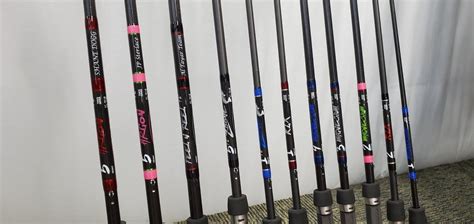Build a Custom Fishing Rod: Personalize Your Fishing Experience
Building your own custom fishing rod is more than just a hobby; it's a journey into crafting a tool perfectly tailored to your fishing style and the specific conditions you frequently encounter. This allows for unparalleled personalization, enhancing your fishing experience and potentially improving your catch rate. Forget generic rods from the store – let's dive into the rewarding world of custom rod building!
Why Build Your Own Custom Fishing Rod?
The primary advantage is personalization. Off-the-shelf rods offer a limited selection of lengths, actions, powers, and materials. Building your own allows you to select components perfectly matched to your target species, preferred fishing techniques, and personal preferences. This leads to a more comfortable, controlled, and ultimately more successful fishing experience.
Beyond personalization, building your own rod fosters a deeper understanding of the equipment you use. You’ll gain valuable insights into rod construction, component selection, and the relationship between rod design and fishing performance. This knowledge translates to better rod maintenance and repair, saving you money in the long run.
Choosing the Right Components: A Deep Dive
Building a custom rod requires careful selection of several key components:
1. Rod Blanks: The Foundation of Your Rod
The rod blank is the backbone of your rod, determining its action, power, and overall feel. Consider these factors:
- Material: Graphite (carbon fiber) is the most common, offering strength and sensitivity. Fiberglass offers more forgiving flex, ideal for beginners or specific techniques.
- Action: This refers to how the rod bends under load. Fast action rods bend primarily in the tip, while slow action rods bend along their entire length. Fast actions are generally better for precision casting, while slow actions excel in absorbing shock when fighting large fish.
- Power: This indicates the rod's ability to lift weight. Light power rods are suitable for smaller fish and lighter lures, while heavy power rods handle larger fish and heavier lures.
2. Guides: Smoothly Guiding Your Line
Guides are essential for directing your line smoothly and preventing friction. Consider:
- Material: Ceramic guides are popular for their durability and smoothness. Titanium guides are lighter and more expensive.
- Type: Different guide types (single foot, double foot, etc.) offer varying degrees of line management and durability.
- Size and Spacing: Properly sized and spaced guides are crucial for optimal casting performance and preventing line tangles.
3. Reel Seat: Securely Holding Your Reel
The reel seat securely holds your fishing reel and should be comfortable in your hand. Consider:
- Material: Aluminum, graphite, and cork are common materials.
- Type: Different reel seat types (sliding band, screw-down, etc.) offer varying levels of adjustability and security.
4. Handle: Comfort and Control
The handle provides comfort and control during casting and fighting fish. Consider:
- Material: Cork is a classic choice, providing a comfortable and secure grip. EVA foam is a more durable and water-resistant alternative.
- Length and Shape: Handle length and shape should be tailored to your personal preference and fishing style.
Building Your Custom Rod: A Step-by-Step Guide
The exact process will vary slightly depending on the components and tools used, but the general steps include:
- Preparing the Blank: Clean and prep the rod blank according to manufacturer instructions.
- Attaching the Guides: Using epoxy resin, carefully attach the guides to the blank according to a guide spacing diagram.
- Installing the Reel Seat: Securely attach the reel seat to the blank using epoxy resin.
- Attaching the Handle: Attach the handle components to the blank using epoxy resin or appropriate adhesive.
- Curing the Epoxy: Allow the epoxy to cure completely according to the manufacturer's instructions.
- Finishing Touches: Once cured, apply a finish coat (e.g., varnish or paint) for protection and aesthetics.
What are the different types of fishing rod blanks?
Fishing rod blanks are available in various materials, each offering distinct characteristics. Graphite blanks are known for their lightweight nature, sensitivity, and strength. Fiberglass blanks provide more flex and are more forgiving, making them suitable for beginners or those fishing in challenging conditions. Composite blanks blend graphite and fiberglass for a balance of properties. Choosing the right blank is crucial to achieve the desired action and power for your custom rod.
How much does it cost to build a custom fishing rod?
The cost of building a custom fishing rod varies significantly depending on the components selected. Using high-end components can significantly increase the cost. However, it can still be cost-effective compared to buying a comparable high-quality, pre-made rod. Planning your build carefully, sourcing components strategically, and considering your budget upfront will ensure you stay within your financial limits.
What tools do I need to build a custom fishing rod?
Building a custom fishing rod requires specialized tools. These tools can include but are not limited to: a guide wrapping tool, epoxy resin, a precision measuring device, sandpaper, and appropriate clamps and adhesives. Many custom rod building supply stores will also offer complete kits with most of the necessary tools. Researching the specific tools needed for your chosen components is important before beginning the project.
Building a custom fishing rod is a rewarding experience that allows for complete personalization. With careful component selection and a methodical approach, you can create a tool that perfectly matches your fishing style and significantly enhances your time on the water. So grab your supplies and start building your dream rod today!

